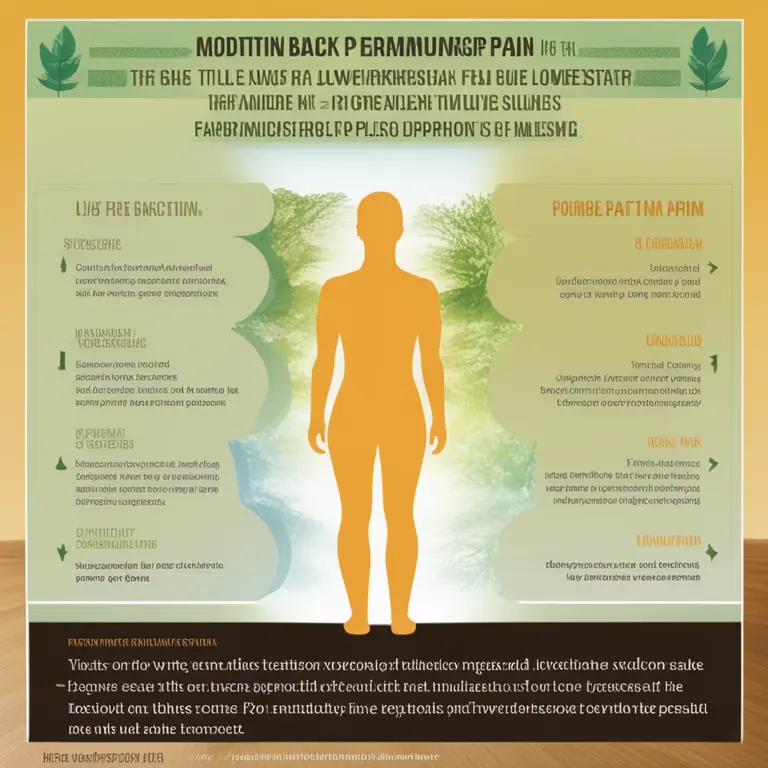
Ease Back Pain with Mindful Meditation
Discover the therapeutic intersection of mindfulness and physical relief with meditation techniques designed specifically for alleviating lower back pain.
article by Hina Kurosawa
Introducing Mindfulness Meditation for Back Pain
Mindfulness meditation, a practice with ancient roots, has gained modern clinical validation for its health benefits. It involves the maintenance of moment-to-moment awareness, gently acknowledging and accepting one's thoughts, feelings, and bodily sensations. For those experiencing lower back pain—a common ailment affecting many—mindfulness meditation may provide significant relief. Chronic pain, by its nature, can trigger a stress response that exacerbates discomfort, creating a vicious cycle. Mindfulness interrupts this cycle, fostering relaxation and pain mitigation. This article delves into mindfulness meditation techniques that could be particularly beneficial for those enduring persistent lower back pain.

The Science Behind Mindfulness and Pain Relief
A growing body of research suggests that mindfulness meditation can reshape the way our brain perceives pain. Neuroscientific studies show that regular practice can lead to changes in brain regions associated with pain modulation. Mindfulness can dampen the activity in the brain's default mode network, the area active during mind-wandering and often associated with increased pain perception. Simultaneously, it strengthens the connections in the anterior cingulate cortex and insula, areas linked to the body's innate pain management. By doing this, practitioners may experience a reduced pain sensation and enhanced emotional resilience against chronic lower back pain.

Starting Your Mindfulness Meditation Practice
Embarking on a mindfulness meditation journey need not be daunting. Begin with a quiet space where interruptions are unlikely. Find a comfortable seated position, either on a chair or a cushion on the floor with your back straight but not rigid. Close your eyes gently. Breathe naturally and focus on the sensation of each breath as it enters and leaves your body. When your attention wanders, as it will, notice where it goes and then kindly return focus to your breath. This primary practice of returning to the breath is the core of mindfulness meditation, which can lead to reduced lower back tension over time.

Body Scan: A Technique for Tackling Pain
An effective method within mindfulness meditation for addressing lower back pain is the "body scan" technique. It involves directing your attention systematically through different parts of the body. Start from the tips of your toes and gradually move upwards to the crown of your head. As you conduct the body scan, you may notice areas of tension or discomfort, acknowledge them, and imagine the pain dissolving with each outbreath. This focused attention helps to release stored tension in the muscles, often contributing to lower back pain relief.

The Role of Consistency and Patience
Like any therapeutic practice, consistency is key to realizing the benefits of mindfulness meditation. Establishing a daily routine, even if for just a few minutes, can significantly impact pain perception and overall well-being. Patience is also vital; the effects of meditation are cumulative and may not be immediate. Over time, with regular practice, many individuals report not only diminished back pain but also reduced stress and anxiety levels, improved mood, and better sleep, which can collectively contribute to healing and quality of life.
Supplementing Meditation with Professional Care
While mindfulness meditation is a powerful tool for managing lower back pain, it is essential to remember that it is complementary to professional medical advice and treatment. Individuals experiencing back pain should seek a healthcare provider’s guidance to devise a comprehensive treatment plan. Mindfulness meditation can then act as a supportive element, enhancing other therapeutic measures such as physical therapy, medication, or sometimes surgery. Together, this integrated approach can pave the way for a more comfortable and active life.
Published: 1/18/2024
Modified: 1/18/2024
More predictions
Come back here soon to learn more about yourself and your future


Mindfulness Meditation: A Path to Lasting Happiness
Discover how mindfulness meditation can enhance your sense of wellbeing and lead you to a happier life in this insightful article.


Mindful Teaching: Meditation Practices for Educators
Discover the benefits of mindfulness meditation for educators seeking balance, enhanced concentration, and emotional wellbeing in a demanding profession.


Mindfulness & Meditation: Enhancing Cognitive Flexibility
Discover how mindfulness meditation can foster cognitive flexibility, improving your ability to adapt to new situations and think creatively.